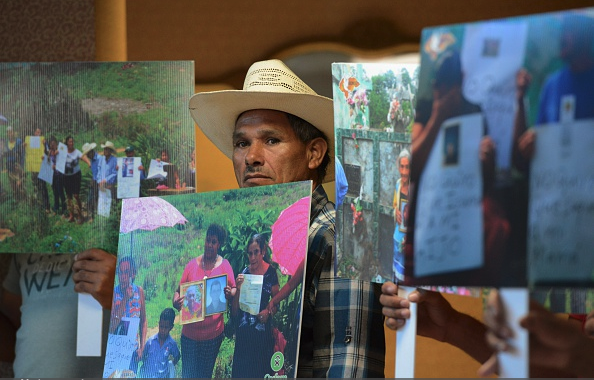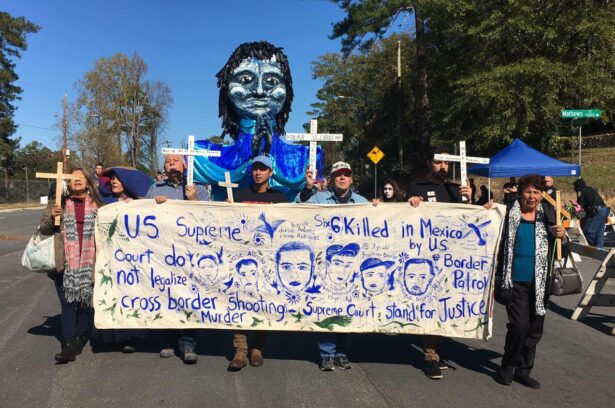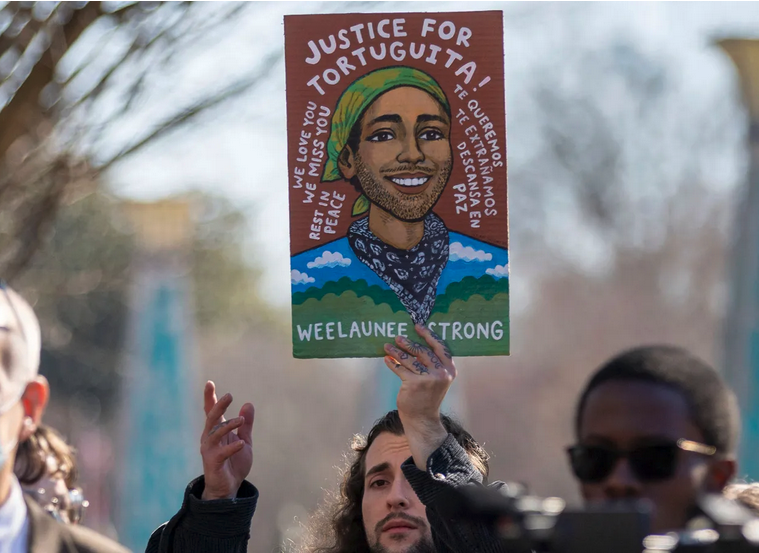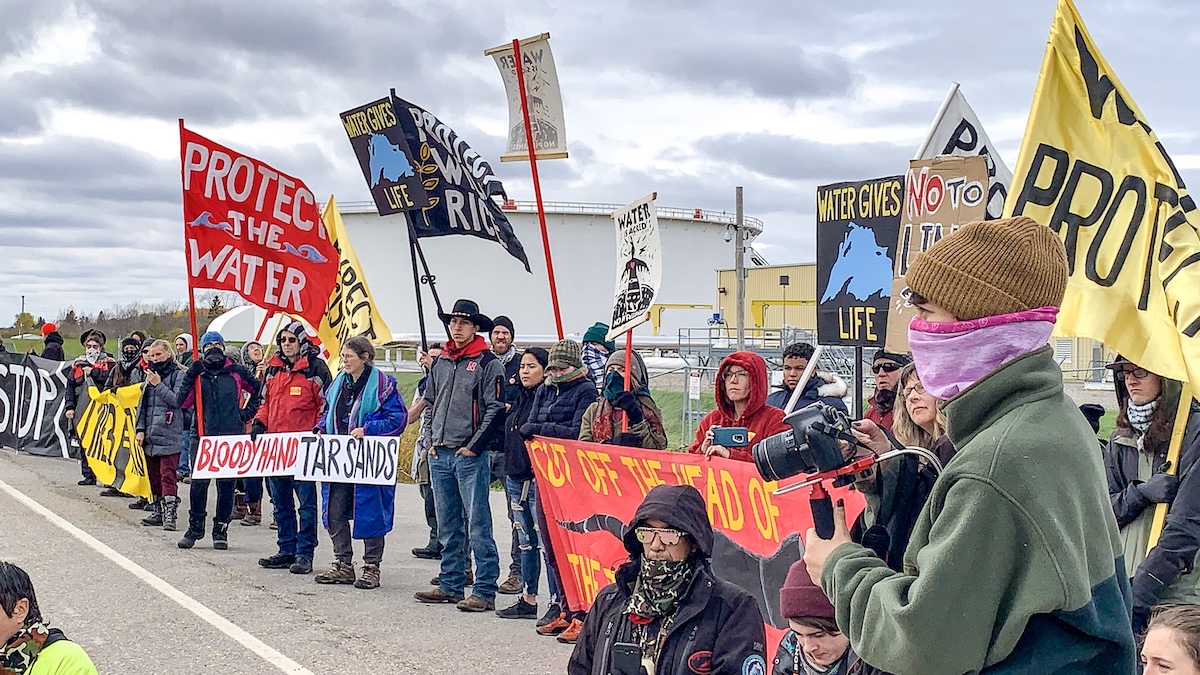From the School of the Americas to Cop City, the U.S. has long been complicit in the death of environmental activists.
by Elena Novak for Waging Nonviolence
Few people outside of Atlanta knew about the police training facility nicknamed “Cop City” when plans were approved in 2021, but all that changed in January when Manual Esteban Páez Terán, known as “Tortuguita,” was murdered by police.
Their death launched a torrent of news coverage, including an article by NBC stating that police had never killed an environmental activist in the U.S. before Tortuguita. That may be true, but the U.S. has long been complicit in the death of activists abroad through its involvement in resource extraction and training police and military personnel.
One such country is Honduras, which had the highest number of killings of land defenders per capita in the world in 2019. There, in the community of Azacualpa, land defenders are fighting against extractivism, despite the real dangers they face. Their struggle and the Stop Cop City movement may seem unrelated, but they are deeply interconnected and both in need of international solidarity to win.
‘A power that we have to confront’
For 200 years, the cemetery in Azacualpa, Honduras was the resting site of generations of Chorti people, descendants of the Indigenous Mayans. But in January 2022, in the middle of the night, the Canadian-based mining company Aura Minerals destroyed the sacred burial site to get at the gold beneath it. In the morning, the people woke up to find the bodies of their loved ones gone — to where, they still have no idea.
The community of Azacualpa is unified under the Committee for People Affected by MINOSA, the subsidiary of Aura Minerals that has operated the San Andrés mine in Azacualpa since 2009 and sold extracted gold abroad to companies that include Asahi Refining and Auramet International, both of which have refineries in the United States.

The committee, along with Witness for Peace Solidarity Collective and the human rights law firm Bufete Estudios para la Dignidad, sent a joint letter at the end of January to Asahi and Auramet to express concerns over their continued business with the mining company and urging them to immediately cut ties.
“When MINOSA took over, their intention was very clear from the very beginning that they were going to destroy the cemetery,” said Jalileh Garcia, a recent graduate of Oxford University and a Honduran native who wrote her master’s dissertation on the mine. “They’re destroying the links, these shared connections that people have between the living and the dead.”
The letter follows a long history of resistance by the community and its supporters. In 2019, human rights organizations brought a case before the Supreme Court of Honduras, which declared that the cemetery was cultural patrimony of the Indigenous community and could not be excavated. In 2020, Aura Minerals fought back by getting a local judge to authorize excavation of the cemetery even though it defied the Supreme Court ruling.
“This just shows that MINOSA functions as a power that is over the state of Honduras, over the authorities of Honduras, and that is a power that we have to confront,” said Pedro Mejia, a lawyer with the firm Bufete Estudios para la Dignidad, which has represented the community since 2018.
The people of Azacualpa have not only used the law but also their bodies to resist the mine. In 2014, the community blockaded the entrance of the mine after learning of the company’s plans to expand into the cemetery, a violation of a 2012 agreement made with municipal authorities and representatives to relocate the mine. A few weeks later, military and police retaliated with beatings, tear gas and arrests. In 2015, the community tried again, prompting more arrests.
The company has also tried to divide the community by causing rifts among families. To get families to sign off on the exhumation of their loved ones, they offered the equivalent of thousands of dollars, a not insignificant amount for a rural community. All it took was the approval of one person, even if the rest of the family was opposed.
“They took advantage of our community’s poverty and offered money in exchange for the exhumations,” said Yessica Rodríguez, a 22-year-old activist who was born in Azacualpa. “At no time did we want to sell our dignity, and yet they violated our rights.”
Now that the cemetery is gone, Garcia says the people are demoralized, but they continue to fight on behalf of the relatives they have lost.
“You’re talking about community members who, because of their bonds with their dead loved ones, continue to resist,” Garcia said. “One man who was physically threatened said, ‘As long as I know that I defended my loved ones, you can kill me right here.’”
The destruction of the cemetery occurred under former President Juan Orlando Hernández, whose presidency ended when he was arrested and extradited to the United States under charges of corruption and involvement in the drug trade. His successor, Xiomara Castro, assumed the presidency as the country’s first female president just days after the cemetery was destroyed. In March, she declared an end to open-pit mining, a commitment she has not yet upheld, though no new permits have been granted to companies like MINOSA.
“We have to put pressure on her,” Rodríguez said, “so that one day we can achieve justice in our community.”
For Rodríguez, the fight is about defending the land for future generations. “In our community there are more than 200 areas where we could get water, but they have disappeared because of the contaminants like cyanide that the company uses, which get discharged into the rivers,” Rodríguez said. “If the mine destroys our population, our forests, then I believe that if tomorrow I have a child, he will not have a place to live, he will not have a place to grow his crops, he will not have a place to drink water.”
‘We need to work together’
Between 2012 and 2021, Global Witness reported that more than 1,733 environmental activists were killed in countries across the world — an average of one person every two days. The narrative around these deaths is often focused on corruption, and the role of the Global North in putting a stop to these human rights atrocities. However, the U.S. is not only complicit in these deaths by buying gold from mines like the one in Azacualpa but it has also trained the perpetrators of these crimes.
In 2016, a group of hitmen murdered Berta Cáceres, a Honduran environmental activist and leader known for opposing the building of a hydroelectric dam on a river sacred to the Indigenous Lenca people. Her murder was coordinated and carried out by men trained by the U.S. military — one at West Point and two at Fort Benning, the former site of the School of the Americas, or SOA, which trained Latin American soldiers and became known for the violent and repressive tactics carried out by its graduates. Fort Benning is also where Derek Chauvin, the Minneapolis cop who killed George Floyd, started his career.
That’s what makes Cop City, or as the Atlanta Police Foundation is calling it, the Public Safety Training Center, so alarming. The original plan for the new training facility involved military-grade training and explosives testing areas on 150 acres of forested land that once housed the Old Prison Farm. Now, after pressure from defenders of the South River Forest, the plan has been scaled down to 85 acres and it will no longer involve explosives testing. However, it will retain elements such as a firing range, “shoot house” and burn building.
Being just 100 miles from Fort Benning, activists say the facility would only increase police violence in a state that already has the fourth highest incarceration rate in the world. “Cop City is the new School of the Americas,” the Stop Cop City movement tweeted in January.

Beyond the SOA’s complicity in human rights abuses and killings throughout Latin America, there’s also a legacy of international solidarity. In 1990, an organization called SOA Watch was formed in protest of the school, organizing die-ins, prayer vigils, blockades, and other forms of nonviolent direct action. In time, it became the largest grassroots Latin America solidarity organization in the U.S., working to challenge the belief that “land, resources and human rights are commodities that can be bought, stolen and destroyed.”
Pedro Mejia, one of the lawyers representing Azacualpa, echoed this sentiment. He said that international solidarity is needed to “confront the extractivist neoliberal economic model, which allows companies like these to settle in territories without anyone’s permission, exercise violence against communities and take all the wealth of the people.”
He also warned that movements and leaders should be on guard to prevent being co-opted or corrupted by outside organizations looking to fund a project and move on. Links with other organizations or communities can, on the other hand, provide some protection. “We, particularly as lawyers, can notify some human rights organizations about the risk to a community leader,” Mejia said, which can decrease or stop the threats they face.
“There have always been employees at the mine who say to us, ‘If the company pays one day, so will you,’” Rodríguez said. “So that is why we always emphasize that if something were to happen to us, the mine is responsible.”
The community knows that sending the letter co-signed by 60 civil society organizations to Asahi and Aurame in January is not enough to win back their land, and they continue to strategize over their next actions.
On March 9, the Movement for Black Lives shared a futuristic newspaper titled “Black Liberation Times,” imagining a world 10 years after the defeat of Cop City and protection of the Weelaunee Forest. It describes the creation of a Tort Community Center, a community space named for Tortuguita, where people could take free classes, garden and take part in workforce development programs. It imagines families finding “play and joy” in the forest.
This is a vision that the people of Azacualpa can relate to. “These are not spaces where it’s just violence and suffering,” Garcia said. “The resistance is about creating a new future.”


